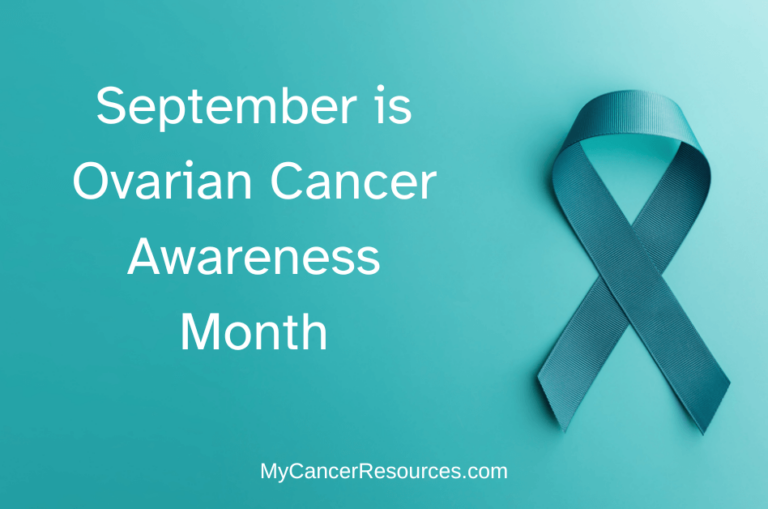
September is Ovarian Cancer Awareness Month. This silent cancer is the deadliest of all cancer of the female reproductive system, and (possibly because it involves the reproductive system) is not openly talked about.
But because this type of cancer can affect any individual with ovaries, it is important to raise awareness so that people know what to do if they have risk factors that may increase their chances of developing ovarian cancer.
I have a personal connection to ovarian cancer. My aunt was diagnosed with ovarian cancer after it was already metastatic. We had very little time with her after her cancer was discovered, and her death devastated me.
My best friend in high school had her stage 2 ovarian cancer found after she was in an accident and was having x-rays for a shattered pelvis. Thankfully, she has NED (no evidence of disease) after having surgery and completing chemo a few years ago.
To recognize Ovarian Cancer Awareness Month, here’s a look at the different types of ovarian cancer, signs of ovarian cancer, and ways it can be treated.
Understanding the Ovaries
The ovaries are small organs located on both sides of the uterus that produce eggs for reproduction and hormones, including estrogen and progesterone.
Eggs are produced in the ovaries, travel through the fallopian tubes and into the uterus where they can be fertilized or shed through the menstrual cycle.
One ovary is on each side of the uterus. Ovarian cancer begins when cancer cells develop either on, in or near the outer layer of an ovary.
Types of Ovarian Cancer
There are more than 30 types of ovarian cancer. The three most common types of cells where ovarian cancer starts include epithelial cells, germ cells and stromal cells:
- Epithelial cancer starts in the tissue covering the outer lining of the ovaries
- Germ cell tumors start in the germ cells, which are egg-producing cells
- Stromal cells produce hormones
Ovarian epithelial cancer is by far the most common type of ovarian cancers. Of all cases of ovarian cancer, 85-90% are this type. There are different types of epithelial ovarian tumors.
Serous ovarian cancer is the most common. Other types include mucinous, endometriod, and clear cell.
Germ cell tumors make up less than 2% of ovarian cancers. These types of tumors may be a mix of different subtypes, and they have the best responses to treatment.
Ovarian stromal tumors make up around 1% of all ovarian cancers. Over half of these types of tumors are found in those over the age of 50.
Statistics/Fast Facts
According the the American Cancer Society, about 19,680 people in the United States will receive an ovarian cancer diagnosis in 2024.
Around 12,740 people will die from the disease in 2024.
Ovarian cancer is the second most common gynecologic cancer in the United States (the most common is endometrial cancer, which is cancer that forms in the lining of the uterus).
The risk of someone with ovaries developing ovarian cancer during their lifetime is about 1 in 87.
Around half of new ovarian cancer cases are found in those 63 or older.
Ovarian cancer is more common in Whites than in Blacks.
The number of diagnoses has been falling, at a rate of almost 3% per year from 2015-2019.
Due to fewer diagnoses and better treatments, the rate of ovarian cancer deaths has decreased by 40% since 1975.
A common misconception is that the Pap smear test or HPV can detect ovarian cancer. This is not true.
These tests check for the presence of cervical cancer or virus cells that can develop into cervical cancer.
Risk Factors for Developing Ovarian Cancer
There are a number of known risk factors that may increase the likelihood of developing ovarian cancer. The largest risk factors are family history of ovarian cancer, a family history of breast cancer, and inheriting a genetic mutation like BRCA1 or BRCA2, or Lynch syndrome.
Family history includes mother, sister, aunt or grandmother with the disease. Additional risk factors include:
- Being overweight/obese
- Being middle aged or older
- Having endometriosis
- Prior use of hormone replacement therapy
- Personal history of breast, uterine, or colon cancer
- Have never given birth or have had problems getting pregnant
- Having an Askenazi Jewish or Eastern European background
Mutations in the BRCA1 or BRCA2 genes are responsible for most inherited ovarian cancers (those who have a close family member with a history of breast or ovarian cancer). These mutations are around 10 times more common in Ashkenazi Jewish people.
Reducing Your Risk of Ovarian Cancer
Research has shown there are a few things that have been linked to a lower risk of developing ovarian cancer:
- Having been pregnant
- Having breastfed their babies
- Having taken oral contraceptives (birth control pills) for at least five years
- Removal of the fallopian tubes and ovaries if they have high-risk genetic mutations like BRCA1 or BRCA2
- Having a hysterectomy that also includes removal of the fallopian tubes
Signs & Symptoms of Ovarian Cancer
Ovarian cancer is a devastating disease in part because it has vague symptoms that are typically first linked to other, less serious conditions.
There are no effective screening tests for ovarian cancer, so that by the time the other issues that could be causing the symptoms are ruled out, the cancer has gone undetected and may have spread.
As in the case of my friend, ovarian cancer can be discovered while being evaluated for another issue. Her cancer had already spread outside of the ovaries by the time doctors found it on a scan.
Common symptoms of ovarian cancer include:
- Abdominal pain and swelling/bloating
- Constipation
- Decreased appetite
- Feeling full quickly while eating or drinking
- Weight loss
- Back or pelvic pain
- Urinating more often than normal
- Fatigue
- Menstrual changes
- Pain during sex
If you have any of these symptoms that last for more than two weeks, or if they get worse, visit your doctor.
Early detection of ovarian cancer (catching it at an early stage) can increase treatment options available to you and often means better survival rates.
How Ovarian Cancer is Diagnosed
In addition to a complete pelvic exam, doctors will use a few tests to help find or rule out ovarian cancer.
One is a transvaginal ultrasound, which uses sound waves to look at the ovaries, uterus and fallopian tubes. This can see if there is a tumor in one or more of those areas, but it cannot tell if the tumor is cancerous or not.
Pelvic imaging can also be done with a CT scan. This scan shows 3D images of the abdomen, pelvis and surrounding lymph nodes. This is helpful to see the tumor and see if it has spread to other areas of the body.
Another test is a CA-125 blood test. CA-125 is a protein that’s found in the blood. Many people with ovarian cancer have high levels of CA-125.
Unfortunately, CA-125 blood tests can come back high when someone has other conditions, like pelvic inflammatory disease or endometriosis.
Also, not everyone with ovarian cancer has high levels of CA-125 in their blood.
A biopsy (removal of a small piece of the tumor) is necessary to confirm a diagnosis of ovarian cancer.
Treating Ovarian Cancer
Surgery
The most common type of ovarian cancer treatment is surgery, especially if it was caught at an early stage. Doctors perform an operation to remove the tumor.
This may include performing a partial hysterectomy which removes the upper part of the uterus.
A total hysterectomy removes the uterus and cervix.
A Bilateral salpingo-oophorectomy removes the ovaries and fallopian tubes.
Chemotherapy
In addition to surgery, chemotherapy is often recommended to try to make sure any cancer cells left in the body after surgery are destroyed.
In some cases, the chemo drugs are heated and given during surgery. Heated chemotherapy has been shown to be helpful against ovarian cancer.
Hormone Therapy
The hormones used to treat ovarian cancer are called luteinizing hormone-releasing hormone agonists, or LHRH. These control how the ovaries produce estrogen, because lowering estrogen levels for those who are premenopausal can slow the growth of ovarian tumors.
These are injections that are given once every 1-3 months, and are mostly used to treat ovarian stromal tumors.
Immunotherapy
Immunotherapy is designed to help the immune system fight cancer cells. When the immune system response is boosted against cancer cells, it can shrink or slow the growth of some tumors.
Most immunotherapy treatments for ovarian cancer are given as an infusion every few weeks.
Targeted Therapy
This type of therapy uses drugs to find cancer cells and block them from repairing or replicating.
One option in this category of treatment is PARP inhibitors. These are especially helpful for ovarian cancer patients with a BRCA mutation.
Some PARP inhibitors can be given as an infusion and some come in pill form.
Radiation Therapy
Radiation is rarely used in the United States as the main treatment for ovarian cancer, since chemotherapy tends to be more effective.
If the cancer has spread to the spinal cord or brain for example, radiation can be helpful in treating these areas.
If someone receives radiation therapy, treatments are given 5 days a week for several weeks.
Other Treatments
Other treatments that may be used through an integrative medicine clinic may recommend additional supplements that may include:
- Quercetin – this is found in fruits and vegetables and in black and green tea. Some studies have shown that it can slow tumor growth.
- Wheat germ extract – this extract can work alongside certain chemotherapy drugs to make it more effective.
- Scutellaria baicalensis Georgi – this Chinese herb has been shown in lab studies to limit the growth of cancer cells.
Final Thoughts on Ovarian Cancer Awareness Month
Ovarian cancer often shows no signs until it’s in advanced stages. That’s why spreading the word and understanding this disease is so important – not just during Ovarian Cancer Awareness Month, but year-round.
Knowing if you’re at a higher risk because of your genes or family history can be a game-changer. It means you and your health care providers can take steps early on, perhaps even before it begins.
Awareness empowers you to ask the right questions and, ideally, catch those warning signs early. Your doctors may even recommend taking birth control pills, since they have a protective effect against ovarian cancer.
Those with a family history may opt to have genetic testing done. This test looks at your DNA to see if you’ve inherited any harmful gene variants like BRCA1 or BRCA2. If a genetic mutation is found, some may decide to have surgery to reduce the chances of developing ovarian cancer.
The Ovarian Cancer Research Alliance provides a free genetic test kit to those who are eligible.
This does not mean jumping straight to a total hysterectomy. Some experts are now suggesting that the first step for those with a family history and/or BRCA gene mutations would be to just remove the fallopian tubes. The ovaries can be removed when the person is older.
Knowing your genetic factors can help you make informed decisions about what the right decisions are for your health.
Despite improvements in the ways ovarian cancer can be treated, this disease still takes far too many people from their loved ones.
I hope a successful screening test is developed so that ovarian cancer can be found at an earlier stage, and that new drugs are discovered that are more effective, especially with advanced stages.
If you or someone you know have one or more of the most important risk factors, talk to your doctor to see what your options are. Pay attention to any strange symptoms you’re having and don’t delay getting them checked out.
If someone you love has ovarian cancer, share this list of free gifts for cancer patients so they can receive some goodies by mail to lift their spirits.
If you or they need support, reach out to me and we can chat about how I can help.
References
https://www.cancer.org/cancer/types/ovarian-cancer/about/key-statistics.html
https://www.cancertodaymag.org/summer-2024/a-different-chemotherapy-approach-for-ovarian-cancer/
https://www.ncbi.nlm.nih.gov/pmc/articles/PMC6570913/



